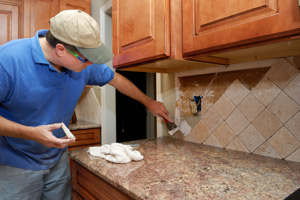Tips & Maintenance
A Guide To Resurfacing Kitchen Countertops
Remodeling a kitchen can be an expensive endeavor. Many of the items needed to update the look of the kitchen can cost hundreds of dollars and require hours of professional installation to complete the task. But there is one way that homeowners can use to update the look of their kitchen without breaking the bank. Resurfacing the kitchen countertops can go a long way towards improving and updating the look of your kitchen at a cost that is a great deal less that purchasing a custom countertop.
 Resurfacing kitchen countertops is an easy and inexpensive way to replace the countertops in your home. Resurfacing erases any signs of wear or damage that may be in present in the existing countertop, creating a countertop that looks brand new. Resurfacing kitchen countertops also allows the homeowner to change the color of the countertop without having to purchase a whole countertop unit. If the homeowner would like to save money on their kitchen remodeling project, resurfacing the kitchen countertops is an economical option and is easy for the homeowner to complete on their own.
Resurfacing kitchen countertops is an easy and inexpensive way to replace the countertops in your home. Resurfacing erases any signs of wear or damage that may be in present in the existing countertop, creating a countertop that looks brand new. Resurfacing kitchen countertops also allows the homeowner to change the color of the countertop without having to purchase a whole countertop unit. If the homeowner would like to save money on their kitchen remodeling project, resurfacing the kitchen countertops is an economical option and is easy for the homeowner to complete on their own.
Typically, resurfacing kitchen countertops can be completed in a matter of hours. There are several different products available for resurfacing kitchen countertops that can be purchased at any home improvement store. There are also a variety of techniques that can be used to resurface the countertop depending on the resurfacing product chosen by the homeowner. Many kitchen countertops come in a standard size, making it easy for the homeowner to know how much material to purchase for the resurfacing project. If the countertop that is being resurfaced is an odd size or shape, the homeowner can take the measurements of the countertop into the home improvement store and obtain assistance from the sales personnel in figuring out how much of the resurfacing product to purchase.
One of the most common materials used for resurfacing kitchen countertops is a sheet of laminate. This is because laminate is a very easy material to use and it comes in a wide variety of colors and designs, making it easy for individuals to find a style that they like. Because laminate material is very thin, it is considered one of the easiest materials to work with. Even individuals that do not possess a great deal of strength have no trouble managing a sheet of laminate material. Resurfacing kitchen countertops with laminate is inexpensive and can be accomplished with very few materials and tools.
The first step in resurfacing kitchen countertops is to prepare the countertop for resurfacing. Any laminate or glue that is already on the countertop will need to be removed so that the new surfacing materials will adhere to the countertop. Stripping the glue and laminate off of a countertop is usually accomplished by the application of a stripping compound to the surface of the countertop. These can be purchased at any home improvement store and can be picked up while the homeowner is purchasing the resurfacing materials. The stripping compound will begin to dissolve the old laminate and glue making it easy for the homeowner to remove.
After the old glue and laminate has been removed, the next step in resurfacing kitchen countertops is to sand the newly exposed surface of the countertop to provide a surface that the new adhesive can adhere to. Once the surface of the countertop has been sanded, the new adhesive should be spread thinly over the entire surface of the countertop. The homeowner should ensure that the adhesive is spread in an even layer so that the laminate that will be placed on top of the adhesive with be even as well. The adhesive should extend all the way to the edges of the countertop to hold the new laminate properly.
Once the adhesive has been applied to the surface of the countertop, the last step is to apply the new laminate material. The laminate should be placed on the countertop starting at one edge and slowly laying it down going towards the other edge. The reason that this step should be done slowly and carefully is to ensure that the laminate is laid properly and is even with the edges of the countertop. A heavy roller may be used to ensure that the laminate material is pressed flat and adhered properly to the adhesive. After this step has been completed, the homeowner may choose to finish the edges of the countertop or leave the countertop the way it is. Either way, they have completed the project with a minimum of expenditure and a little bit of hard work.